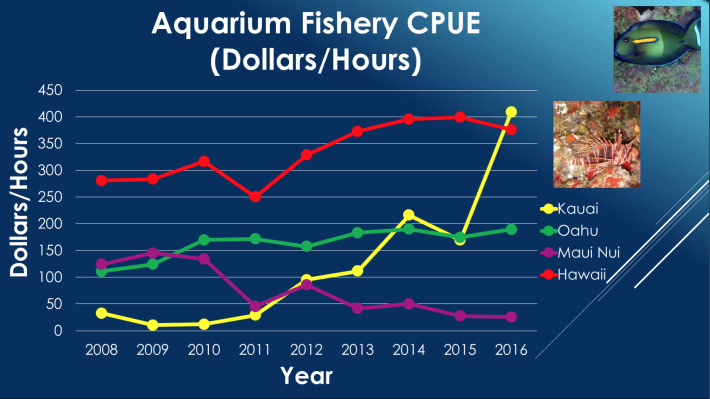In September, when the Hawai‘i Supreme Court ruled that commercial aquarium fish collection permits issued by the state Department of Land and Natural Resources require an environmental review, many thought an injunction closing the fishery would soon follow. The high court had remanded the matter of crafting an injunction to the lower court. Last month, Circuit Judge Jeffrey Crabtree allowed fishery representatives to intervene in the case and had not issued an injunction by mid-month.
Displeased with the pace at which Crabtree was implementing the high court’s order, as well as his decision to allow the Pet Industry Joint Advisory Council (PIJAC) to join the case, the plaintiffs — Rene Umberger, Mike Nakachi, Willie and Kaimi Kaupiko, Conservation Council for Hawai‘i, and the Humane Society of the United States — filed on October 23 a petition for a writ of mandamus with the state Supreme Court, seeking to force an immediate closure.
“Unfortunately, he [Crabtree] has delayed what the Hawai‘i Supreme Court has ordered him to do, which is to enjoin commercial aquarium collection,” said Earthjustice attorney Paul Achitoff, who represents the plaintiffs. Crabtree had scheduled a hearing for October 27 to consider evidence on the form of relief he would order, but the Hawai‘i Supreme Court had already decided that, Achitoff continued.
Rather than signing the plaintiffs proposal for an immediate injunction, submitted on October 3, Crabtree asked the parties to file “any appropriate motions” regarding injunc- tive relief “and is entertaining a full-blown evidentiary hearing, at PIJAC’s request. Moreover, the Circuit Court’s scheduling order regarding injunctive relief does not have a completion date for issuing the pro- hibitory injunction this Court ordered weeks ago,” the petition states.
The Supreme Court did not authorize the Circuit Court to “receive evidence regarding the purported harmlessness of the ongoing illegal extraction of public trust resources, or require Petitioners to prove anew what this Court already has found,” the petition adds.
The DLNR responded to the petition in a press release. The agency reiterated its belief that current aquarium fishing practices are sustainable and environmentally sound and noted that “dozens of local businesses and families depend on the industry for their livelihoods.”
At last month’s meeting of the Western Pacific Fisheries Management Council, Ryan Okano of the DLNR’s Division of Aquatic Resources presented data showing that the aquarium fishery is by far the most valuable of the state’s inshore fisheries, generating an average annual revenue of about $2.25 million dollars, mostly from fish collected around Hawai‘i island. (The state’s reef fish and bottomfish fisheries were tied at a distance second, each generating about $1.5 million a year between 2012 and 2017.)
To bolster the DLNR’s case that the fishery is, indeed, sustainable, despite the fact that each commercial permit allows unlimited commercial take, Okano showed charts depicting the trends in the number of animals caught per hour and the revenue generated per hour between 2008 and 2016. Except for perhaps Maui Nui, the “catch per unit effort” trends for both scenarios were generally stable or increased for all islands, the charts indicated.
Given that that vast majority of the fish collected for the aquarium trade are taken from waters off West Hawai‘i, Okano presented evidence that suggested that fish replenishment areas (FRAs) established by the department more than a decade ago and spanning more than a third of the coastline have successfully protected populations of the most collected species.
Populations of yellow tang, which made up more than 75 percent of the West Hawai‘i aquarium catch in 2016, have increased within FRAs and marine protected areas, skyrocketing in the last few years, the DLNR found. Outside the protected areas, populations have fluctuated, but have been on an increasing trend since 2011. For kole, the second most collected species in West Hawai‘i, and for the rest of the ten most-collected species, population trends in all areas have increased between 1999 and 2016, Okano’s chart’s showed.
“From our perspective, the fishery seems to be doing okay. … We see it as a sustainable fishery. That’s why we struggle now. We’re probably going to have more rules on it,” Okano said.
Whether or not the fishery is sustainable, the plaintiffs argue that the Hawai‘i Supreme Court found in September that all 300 or so existing commercial aquarium collecting permits are in violation of the Hawai‘i Environmental Policy Act, and are, therefore, illegal. While PIJAC has argued to Crabtree that existing permits should be excluded from any injunction, “excluding existing permit holders from the injunction would render an injunction meaningless as a practical matter, making a mockery of [the Hawai‘i Supreme] Court’s decision,” the petition states. What’s more, it adds that the high court “did not leave room for the Circuit Court to undertake any ‘tailoring’ analysis, nor to parse which commercial permits may or may not be covered under the injunction.”
On October 27, Crabtree ruled that all existing commercial aquarium fish permits are illegal and invalid, but denied the plaintiffs’ request for a moratorium pending completion of the environmental review process. The DLNR said it “respects Judge Crabtree’s ruling and will fully comply so long as it remains in effect.”
— Teresa Dawson



Leave a Reply